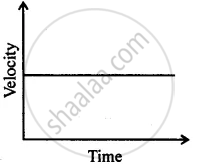Advertisements
Advertisements
Question
A body starting from rest travels with uniform acceleration. If it travels 100 m in 5 s, what is the value of acceleration ?
Solution
We have to find the acceleration of the body. We have the following information given, Initial velocity,
Let the acceleration be (a)
Time taken,(t) = 5 s
Distance travelled, (s) = 100 m
We can calculate the distance travelled by using the 2nd equation of motion,
`s = ut + 1/2at^2`
Put the values in above equation to find the acceleration of the body ,
`100 = 0(5) + 1/2(a)(5^2)`
On further simplification ,
`(25a)/2` = 100
therefore,
`a = 200/25`
= `8 "m/s"^2`
APPEARS IN
RELATED QUESTIONS
Define velocity. What is the SI unit of velocity ?
Derive the formula s= `ut+1/2at^2` , where the symbols have usual meanings.
A car is travelling along the road at 8 ms-1. It accelerates at 1 ms-2 for a distance of 18 m. How fast is it then travelling ?
A freely falling object travels 4.9 m in 1st second, 14.7 m in 2 nd second, 24.5 m in 3rd second, and so on. This data shows that the motion of a freely falling object is a case of :
Give one example of following motion :
Variable acceleration
If a stone and a pencil are dropped simultaneously in vacuum from the top of a tower, then which of the two will reach the ground first? Give reason.
State how the velocity-time graph can be used to find
The acceleration of a body
The figure shows the displacement - time graph for four bodies A, B C and D. In each case state what information do you get about the acceleration (zero, positive or negative).

Can you suggest a real-life example about the motion of a body from the following velocity – time graph?

A stone thrown vertically upwards takes 3 s to attain maximum height. Calculate
- initial velocity of the stone
- maximum height attained by the stone. (Take g = 9.8 ms−2)
